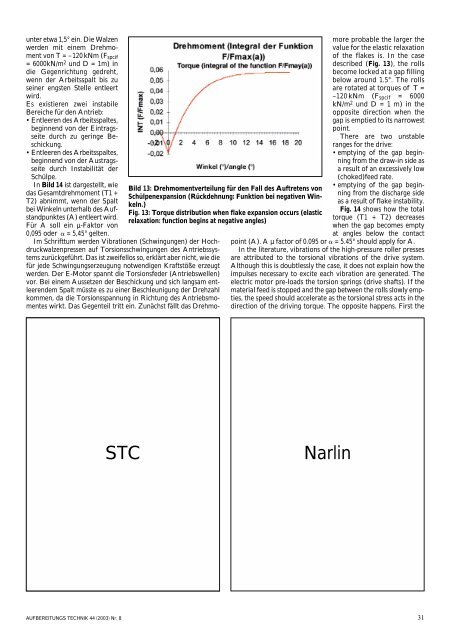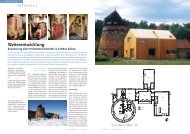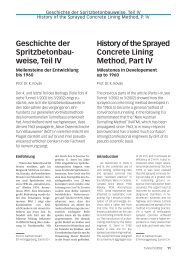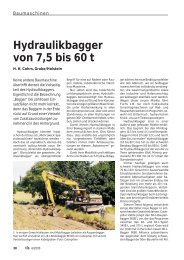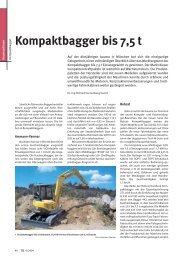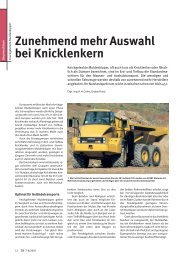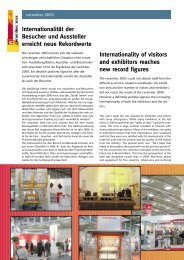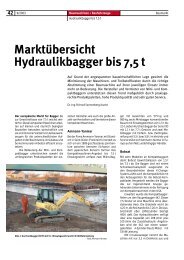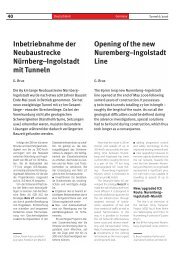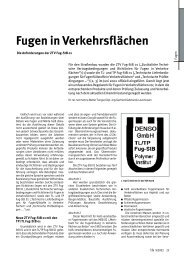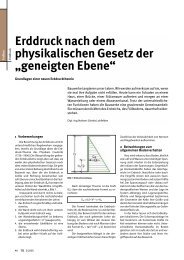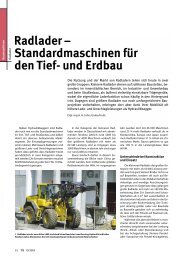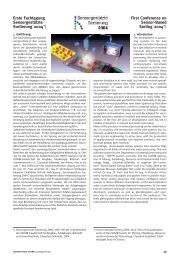Kraftverteilung im Arbeitsspalt von Hochdruck ... - Bauverlag
Kraftverteilung im Arbeitsspalt von Hochdruck ... - Bauverlag
Kraftverteilung im Arbeitsspalt von Hochdruck ... - Bauverlag
Erfolgreiche ePaper selbst erstellen
Machen Sie aus Ihren PDF Publikationen ein blätterbares Flipbook mit unserer einzigartigen Google optimierten e-Paper Software.
unter etwa 1,5° ein. Die Walzen<br />
werden mit einem Drehmoment<br />
<strong>von</strong> T = –120 kNm (F spcif<br />
= 6000kN/m 2 und D = 1m) in<br />
die Gegenrichtung gedreht,<br />
wenn der <strong>Arbeitsspalt</strong> bis zu<br />
seiner engsten Stelle entleert<br />
wird.<br />
Es existieren zwei instabile<br />
Bereiche für den Antrieb:<br />
• Entleeren des <strong>Arbeitsspalt</strong>es,<br />
beginnend <strong>von</strong> der Eintragsseite<br />
durch zu geringe Beschickung.<br />
• Entleeren des <strong>Arbeitsspalt</strong>es,<br />
beginnend <strong>von</strong> der Austragsseite<br />
durch Instabilität der<br />
Schülpe.<br />
In Bild 14 ist dargestellt, wie<br />
das Gesamtdrehmoment (T1 +<br />
T2) abn<strong>im</strong>mt, wenn der Spalt<br />
bei Winkeln unterhalb des Aufstandpunktes<br />
(A) entleert wird.<br />
Für A soll ein µ-Faktor <strong>von</strong><br />
0,095 oder = 5,45° gelten.<br />
Bild 13: Drehmomentverteilung für den Fall des Auftretens <strong>von</strong><br />
Schülpenexpansion (Rückdehnung: Funktion bei negativen Winkeln.)<br />
Fig. 13: Torque distribution when flake expansion occurs (elastic<br />
relaxation: function begins at negative angles)<br />
Im Schrifttum werden Vibrationen (Schwingungen) der <strong>Hochdruck</strong>walzenpressen<br />
auf Torsionsschwingungen des Antriebssystems<br />
zurückgeführt. Das ist zweifellos so, erklärt aber nicht, wie die<br />
für jede Schwingungserzeugung notwendigen Kraftstöße erzeugt<br />
werden. Der E-Motor spannt die Torsionsfeder (Antriebswellen)<br />
vor. Bei einem Aussetzen der Beschickung und sich langsam entleerendem<br />
Spalt müsste es zu einer Beschleunigung der Drehzahl<br />
kommen, da die Torsionsspannung in Richtung des Antriebsmomentes<br />
wirkt. Das Gegenteil tritt ein. Zunächst fällt das Drehmomore<br />
probable the larger the<br />
value for the elastic relaxation<br />
of the flakes is. In the case<br />
described (Fig. 13), the rolls<br />
become locked at a gap filling<br />
below around 1.5°. The rolls<br />
are rotated at torques of T =<br />
–120 kNm (F spcif = 6000<br />
kN/m 2 und D = 1 m) in the<br />
opposite direction when the<br />
gap is emptied to its narrowest<br />
point.<br />
There are two unstable<br />
ranges for the drive:<br />
• emptying of the gap beginning<br />
from the draw-in side as<br />
a result of an excessively low<br />
(choked)feed rate.<br />
• emptying of the gap beginning<br />
from the discharge side<br />
as a result of flake instability.<br />
Fig. 14 shows how the total<br />
torque (T1 + T2) decreases<br />
when the gap becomes empty<br />
at angles below the contact<br />
point (A). A µ factor of 0.095 or = 5.45° should apply for A.<br />
In the literature, vibrations of the high-pressure roller presses<br />
are attributed to the torsional vibrations of the drive system.<br />
Although this is doubtlessly the case, it does not explain how the<br />
<strong>im</strong>pulses necessary to excite each vibration are generated. The<br />
electric motor pre-loads the torsion springs (drive shafts). If the<br />
material feed is stopped and the gap between the rolls slowly empties,<br />
the speed should accelerate as the torsional stress acts in the<br />
direction of the driving torque. The opposite happens. First the<br />
STC<br />
Narlin<br />
AUFBEREITUNGS TECHNIK 44 (2003) Nr. 8 31


